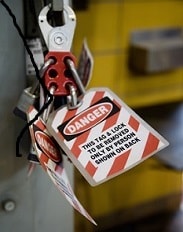Hazardous Energy Control (Lockout and Other Means)
Members from the National Occupational Research Agenda (NORA) Manufacturing Sector Council reviewed, adapted and compiled resources to create this resource guide to help companies start or improve and maintain their existing Hazardous Energy Control/Lockout Program.
Please feel free to contact us or comment about the site at the related CDC NIOSH science blog post: Improving Programs to Control Hazardous Energy: New website offers tools and templates
Overview

It is a matter of life and death. Hazardous energy control is more than Lockout. It encompasses Machine Guarding, Alternative Measures (alternative guarding arrangement that prevents exposure to hazardous energy), Lockout, and other methods of ensuring worker safety from contact with hazardous energy. Here you will find information on regulatory requirements, general guidance and procedures that your company can use to implement an effective Hazardous Energy Control (Lockout/Tagout) Program and prevent unexpected energizing, start-up or release of stored energy which could cause serious injury or death to workers. Injuries related to Lockout often occur when an employee services or repairs a machine or tries to clear a jam but fails to de-energize the machine and lockout sources of energy. Problems can also occur during the process of re-energizing.
Sources of energy are not only electrical; they can also include mechanical, hydraulic, pneumatic, chemical, thermal, or other sources of energy. The failure to develop and use hazardous energy control (Lockout) procedures is one of OSHA’s annual top 10 most frequently cited workplace safety violations. Injuries and fatalities that happen for failure to implement a Lockout Program are much more costly than the citations (not only in economic terms). A comprehensive, written, diligently planned and executed Hazardous Energy Control (Lockout) Program protects the life, and the safety and health of workers; it is a very important part of machine maintenance and production servicing operations.
The Hazardous Energy Control (Lockout and Other Means) Resource Guide offers sample Lockout materials and templates to help with the implementation of effective strategies to control the release of hazardous energy. Members of the Manufacturing Sector Council compiled, reviewed, and adapted resources to help companies and businesses start or improve and maintain their existing Lockout Program. Companies must have a program outlining the steps to de-energize machines and lock out all sources of energy. A successful program will consist of 4 main activities:
- energy control procedures;
- employee training;
- auditing or periodic inspections (to ensure that before service, maintenance are performed machines are effectively locked and tagged to prevent their starting); and,
- planning and acquiring or designing equipment that will accommodate lockout procedures.
DISCLAIMER: Information and materials included on the Hazardous Energy (Lockout Tagout) webpages were compiled from non-NIOSH sources and reviewed and adapted for use by the NORA Manufacturing Sector Council. As such, content presented does not necessarily represent the views of NIOSH. Additionally, mention of any company or product does not constitute endorsement by NIOSH.